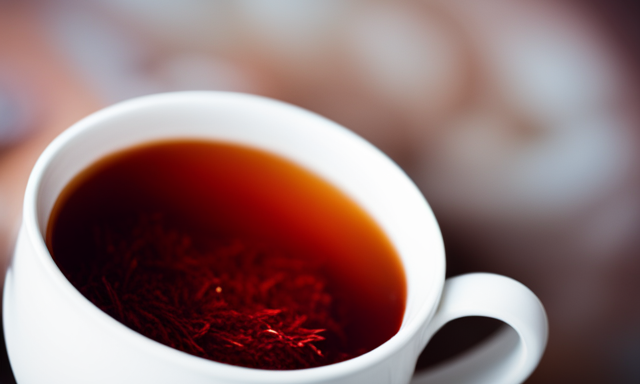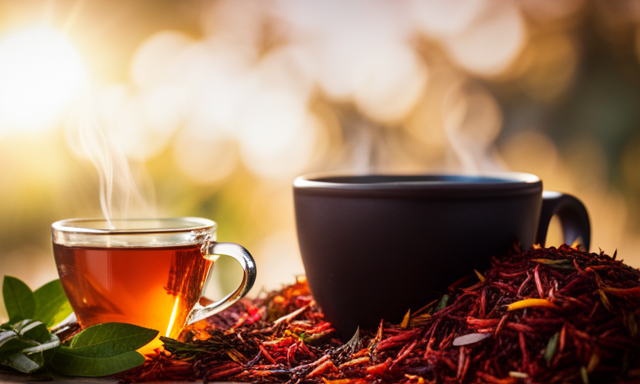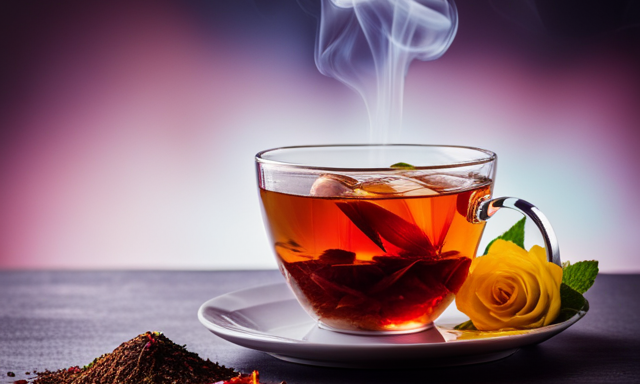Have you ever wondered why rooibos is not considered tea?
Well, let me tell you, it’s a mind-blowing revelation! As a self-proclaimed tea enthusiast, I was astonished to discover that rooibos doesn’t actually come from the Camellia sinensis plant like traditional teas. Instead, it hails from the Aspalathus linearis plant, which is native to South Africa.
This fascinating distinction sets rooibos apart from your typical black, green, or oolong teas. In this article, we will delve into the origins of rooibos, explore the differences between tea and rooibos, and uncover the unique flavor profile and health benefits of this beloved beverage.
Join me on this journey as we unravel the mysteries of rooibos and gain a deeper understanding of why it stands in a league of its own. Get ready to have your tea-loving world turned upside down!
Key Takeaways
- Rooibos is not considered tea because it comes from a different plant, Aspalathus linearis, not the Camellia sinensis plant like traditional teas.
- Rooibos undergoes oxidation and drying, while tea is fermented, oxidized, and sometimes roasted.
- Rooibos belongs to the legume family and is naturally caffeine-free with zero tannins.
- Rooibos is an herbal infusion, not a tea, and is also known as red bush tea or bush tea.
The Origins of Rooibos
You won’t believe the fascinating history of how rooibos came to be! The history of rooibos is deeply rooted in South African culture and has been a cherished beverage for centuries.
The indigenous Khoisan people were the first to discover the delicious and healthful properties of the rooibos plant. They would harvest the leaves, ferment them, and then brew a fragrant and flavorful tea-like beverage.
This traditional drink soon gained popularity among the Dutch settlers who arrived in the Cape of Good Hope in the 17th century. Over time, rooibos became an integral part of South African culture, enjoyed by people of all backgrounds.
It’s incredible how the cultural significance of rooibos has endured throughout history. Now, let’s delve into the details of the rooibos plant and its unique qualities.
The Rooibos Plant
Surprisingly, the invigorating aroma of the Rooibos plant fills the air, captivating the senses with its unique blend of earthy and floral notes. Native to the Cederberg region of South Africa, this remarkable plant has been cherished for centuries for its numerous health benefits.
Rooibos is known to contain high levels of antioxidants, which can help protect the skin from damage caused by free radicals, resulting in a more youthful and radiant complexion. Furthermore, it is rich in minerals such as calcium, magnesium, and zinc, which contribute to strong and healthy bones.
With its low caffeine content and zero tannins, Rooibos is a great alternative to traditional tea. Its soothing properties make it suitable for any time of the day, promoting relaxation and aiding in digestion.
Moving on to the differences between tea and Rooibos…
The Differences Between Tea and Rooibos
Tea and Rooibos are distinct from each other in several key ways. Firstly, they belong to different plant families. Tea comes from the Camellia sinensis plant, while Rooibos is derived from the Aspalathus linearis plant.
Secondly, their processing methods differ significantly. Tea is fermented, oxidized, and sometimes roasted. On the other hand, Rooibos undergoes a process of oxidation and drying.
Lastly, the caffeine content in tea is higher compared to Rooibos, making the latter a popular choice for those seeking a caffeine-free alternative.
Plant families
Contrary to popular belief, rooibos actually belongs to the legume family, not the tea family. This distinction is based on plant genetics and is important because it helps us understand the medicinal properties of rooibos.
As part of the legume family, rooibos shares traits with other leguminous plants, such as the ability to fix nitrogen in the soil. This unique ability contributes to the plant’s rich nutritional content, including antioxidants and minerals.
Furthermore, rooibos contains compounds like aspalathin and quercetin, which have been linked to various health benefits, such as reducing inflammation and promoting heart health.
Understanding the plant family of rooibos allows us to appreciate its unique qualities and potential health benefits.
Moving on to the next topic, let’s explore the different processing methods used for rooibos.
Processing methods
One of the most popular methods for processing rooibos involves fermenting the leaves to enhance their flavor and aroma. This process is unique to rooibos and sets it apart from other traditional teas. Unlike black or green tea, which undergo oxidation during processing, rooibos leaves are first harvested, then bruised and left to ferment for a period of time.
This fermentation process brings out the natural sweetness of the leaves and gives rooibos its distinctive taste. The health benefits of rooibos are also attributed to its processing method. Fermentation helps to release antioxidants and other beneficial compounds, making rooibos a rich source of polyphenols and minerals.
As we explore the next section about caffeine content, it’s important to note that rooibos is naturally caffeine-free, making it a popular choice for those looking for a caffeine-free alternative to traditional tea.
Caffeine content
In the previous section, I discussed the different processing methods used for rooibos. Now, let’s delve into the caffeine content of this drink.
One of the main reasons why rooibos is not considered a tea is because it is naturally caffeine-free. Unlike traditional teas, which contain varying amounts of caffeine, rooibos provides a caffeine-free alternative for those seeking a warm, soothing beverage without the stimulating effects of caffeine.
Here are four key points to consider about rooibos’s caffeine content and health benefits:
-
Caffeine-free: Rooibos is a great option for individuals who are sensitive to or trying to avoid caffeine.
-
Relaxing properties: The absence of caffeine in rooibos can contribute to a calming effect on the body and promote relaxation.
-
Antioxidant-rich: Rooibos is packed with antioxidants that have been linked to various health benefits, including reducing inflammation and protecting against certain diseases.
-
Hydration: Rooibos can be a hydrating choice due to its lack of caffeine, making it a suitable beverage for any time of day.
Now, let’s explore the flavor profile of rooibos and understand why it’s loved by many.
The Flavor Profile of Rooibos
Rooibos has a distinct flavor profile that sets it apart from other beverages. It has a naturally sweet and earthy taste, with hints of vanilla and honey. There are also various varieties and blends of rooibos available, allowing for different flavor experiences.
When it comes to pairing suggestions, rooibos pairs well with a range of foods, from light salads to rich desserts, making it a versatile and enjoyable choice.
Sweet and earthy taste
Imagine savoring the delightful blend of sweet and earthy flavors that rooibos offers. It’s this unique flavor profile that sets rooibos apart from traditional teas.
The sweet notes of rooibos provide a natural sweetness that’s satisfying to the palate, without the need for added sugars or sweeteners. On the other hand, the earthy undertones give rooibos a complex and grounding taste that’s reminiscent of the African soil where it’s grown.
Beyond its flavor profile, rooibos also boasts a range of health benefits, including its high antioxidant content and potential anti-inflammatory properties. These qualities make rooibos a popular choice for those seeking a healthy and flavorful beverage alternative.
As we delve into the next section about varieties and blends, we’ll explore the different ways in which rooibos can be enjoyed.
Varieties and blends
Get ready to explore the wide array of different types and combinations that’ll take your taste buds on a flavorful journey. When it comes to rooibos, there’s a varieties selection that caters to every taste preference. From classic rooibos to flavored blends like vanilla or citrus, the options are endless.
Each variety brings its own unique characteristics, whether it’s a bold and robust flavor or a delicate and floral note. Brewing techniques play a crucial role in bringing out the best in these varieties. The temperature and steeping time can greatly affect the taste profile, so it’s important to experiment and find the perfect balance.
Now that we’ve delved into the world of rooibos varieties and brewing techniques, let’s move on to explore the exciting pairing suggestions that’ll elevate your rooibos experience.
Pairing suggestions
Prepare your taste buds for a tantalizing adventure as we delve into the art of pairing rooibos with delectable treats.
When it comes to pairing suggestions, rooibos offers a versatile and unique flavor profile that can complement a wide range of foods.
For a sweet and fruity twist, try pairing rooibos with berries or citrus desserts.
The natural earthiness of rooibos also pairs well with nuts and dark chocolate, creating a harmonious blend of flavors.
Additionally, the mild and slightly nutty taste of rooibos can be a perfect match for creamy cheeses or buttery pastries.
These pairing suggestions not only enhance the taste of rooibos but also provide a delightful experience for your palate.
Now, let’s explore the health benefits of rooibos and discover its remarkable properties.
The Health Benefits of Rooibos
To understand the health benefits of Rooibos, you can start by considering a case study of Sarah, a regular Rooibos drinker, who noticed a significant improvement in her digestion after incorporating it into her daily routine.
Rooibos has been linked to various health benefits, including heart health and skin health. Studies have shown that Rooibos can help reduce the risk of heart disease by improving blood lipid levels and reducing inflammation. Additionally, the antioxidants present in Rooibos can promote healthy skin by fighting free radicals and reducing oxidative stress.
These benefits make Rooibos a great choice for those looking to improve their overall well-being.
Moving on to the next section about Rooibos as an herbal infusion, it’s important to note its unique properties and how it differs from traditional teas.
Rooibos as an Herbal Infusion
When it comes to discussing rooibos, it’s important to note that it isn’t actually classified as a tea. Instead, it’s considered an herbal infusion because it doesn’t come from the Camellia sinensis plant. Rooibos is also known by alternative names like red bush tea or bush tea.
Additionally, there are a variety of popular rooibos blends available. These include flavored blends with fruits, spices, and herbs, making it a versatile and enjoyable beverage choice.
Infusion vs. tea classification
Although rooibos shares similarities with tea, its classification as an infusion stems from its unique preparation method and distinct flavor profile.
Unlike traditional tea, which is made from the leaves of the Camellia sinensis plant, rooibos is derived from the leaves of the Aspalathus linearis plant. This key difference in botanical origin is what sets rooibos apart and gives it the classification of an herbal infusion.
Additionally, the process of making rooibos involves fermentation, which further distinguishes it from tea. This fermentation process enhances the flavor of rooibos, resulting in a naturally sweet and earthy taste.
The infusion benefits of rooibos are also notable, as it is caffeine-free and rich in antioxidants.
Moving forward, let’s explore the alternative names for rooibos and their significance in its cultural heritage.
Alternative names for rooibos
Nicknamed ‘red bush’ for its vibrant color, this South African herbal infusion has various alternative names that reflect its cultural significance. Here are some of the alternative names for rooibos:
-
Asbos: This Afrikaans term translates to ‘ash bush,’ referring to the plant’s ash-colored leaves.
-
Bush tea: A common name for rooibos, highlighting its resemblance to traditional tea.
-
Red tea: This name emphasizes the infusion’s rich red hue.
-
Long life tea: In some cultures, rooibos is believed to promote longevity and good health.
These alternative names not only provide insight into the cultural significance of rooibos but also reflect the diverse ways in which it is perceived and used.
Now, let’s explore the popular rooibos blends that showcase its versatility and unique flavor profiles.
Popular rooibos blends
If you’re looking to explore popular rooibos blends, you’ll be fascinated to know that over 60% of rooibos enthusiasts prefer the naturally sweet and fruity flavors of rooibos mixed with dried fruits like berries and citrus. These blends not only offer a delightful taste but also provide numerous health benefits.
Rooibos is known for its high antioxidant content, which can help boost the immune system and protect against chronic diseases. Additionally, rooibos has been found to have anti-inflammatory properties and may aid in digestion.
When it comes to brewing techniques, rooibos requires a slightly longer steeping time compared to traditional teas, typically around 5-7 minutes. This allows for the full extraction of its flavors and beneficial compounds.
Transitioning to the next section about ‘rooibos in popular culture,’ it’s worth noting that these blends have gained popularity worldwide for their unique taste and health benefits.
Rooibos in Popular Culture
Rooibos, a beloved South African herbal beverage, has made its way into popular culture, leaving a lasting impression on tea enthusiasts worldwide. It has been featured in movies and literature, showcasing its cultural significance and unique flavor profile.
In movies, rooibos has been portrayed as a comforting drink, often enjoyed by characters during moments of reflection or relaxation.
In literature, it has been used as a symbol of African heritage and a connection to nature.
Its inclusion in popular culture has helped to increase awareness and appreciation for this caffeine-free alternative to traditional tea.
As we transition into the next section about sustainability and rooibos, it’s important to recognize the impact that popular culture has had in promoting the cultivation and conservation of this precious plant.
Sustainability and Rooibos
When discussing the sustainability of rooibos farming, it’s important to consider the use of responsible and eco-friendly farming practices. These practices aim to minimize the environmental impact of cultivation and ensure the long-term viability of the rooibos plant.
Additionally, fair trade certifications play a crucial role in promoting fair and ethical trade practices. They ensure that farmers are paid a fair price for their labor and products.
Lastly, conservation efforts are key to protecting the natural habitat and biodiversity of the rooibos plant. They also preserve the unique ecosystem in which it thrives.
Sustainable farming practices
Despite its reputation as a tea, rooibos is actually farmed using sustainable practices. Rooibos farmers employ a variety of sustainable farming techniques to minimize their environmental impact.
For instance, they use natural fertilizers, such as compost and animal manure, instead of synthetic chemicals. They also practice crop rotation, which helps maintain soil fertility and prevent erosion. Additionally, rooibos farmers employ water conservation methods, such as drip irrigation, to minimize water usage.
These sustainable farming practices ensure that the rooibos industry remains environmentally responsible and doesn’t contribute to deforestation or soil degradation.
Transitioning to the subsequent section on fair trade certifications, it’s important to consider not only the sustainability of rooibos farming but also the ethical and social aspects of its production.
Fair trade certifications
One important aspect to consider in the production of rooibos is the presence of fair trade certifications. Fair trade practices and ethical sourcing are crucial when it comes to the sustainability and social responsibility of rooibos farming. These certifications ensure that farmers receive fair prices for their products, improve their working conditions, and promote community development. By supporting fair trade, consumers can contribute to the well-being of rooibos farmers and their families.
To further understand the significance of fair trade certifications, let’s take a look at the table below:
| Benefits of Fair Trade Certifications | ||
|---|---|---|
| Fair Prices | Improved Working Conditions | Community Development |
Fair trade certifications not only guarantee that farmers are paid fair prices for their rooibos, but also ensure that their working conditions are improved, creating a sustainable and ethical supply chain. Moreover, these certifications promote community development, empowering local communities and fostering a more equitable society.
With fair trade practices in place, the focus then shifts to conservation efforts, which play a vital role in preserving the environment and maintaining the quality of rooibos for generations to come.
Conservation efforts
As we discussed earlier, fair trade certifications play a crucial role in ensuring that farmers receive fair wages and are treated ethically. However, conservation efforts are equally important in the context of sustainable farming practices.
Rooibos, being a plant native to the Cederberg region of South Africa, requires specific environmental conditions to thrive. Therefore, conservation efforts are essential to protect the natural habitat of rooibos and ensure its long-term survival. Many rooibos farms actively engage in conservation initiatives, such as reforestation programs, water management systems, and biodiversity preservation. These efforts not only safeguard the delicate ecosystem but also contribute to the sustainability of the rooibos industry.
By implementing sustainable farming practices and supporting conservation efforts, we can secure the future of rooibos and its unique properties.
Now, let’s explore how rooibos is enjoyed around the world.
Rooibos Around the World
Rooibos, also known as red bush tea, has gained global popularity and is consumed by people all around the world. Different cultures have incorporated rooibos into their daily lives, using it as a refreshing beverage or as an ingredient in various products.
From South Africa to Japan, rooibos-based beverages and products have become increasingly prevalent, showcasing the versatility and appeal of this unique herbal infusion.
Global popularity and consumption
Despite its global popularity and consumption, rooibos is not considered a tea due to its unique characteristics and production process. Rooibos has gained significant traction in the global market, with its consumption spreading far and wide.
Its rise in popularity can be attributed to its numerous health benefits and its delicious, naturally sweet taste. Rooibos has also acquired cultural significance in various countries, becoming a staple in their daily routines. In South Africa, where it originates, rooibos is deeply rooted in the local culture and is enjoyed by people of all ages.
Similarly, in countries like Germany and Japan, rooibos has become a popular alternative to traditional tea, appreciated for its caffeine-free nature and soothing properties.
Transitioning into the next section, it is interesting to explore how rooibos is embraced in different cultures and the unique ways it is prepared and enjoyed.
Rooibos in different cultures
Rooibos has found its place in various cultural traditions, bringing a unique and delightful experience to people around the world. In tea ceremonies, rooibos is often included as a special offering, symbolizing warmth, comfort, and relaxation. Its vibrant red color and sweet, earthy flavor make it a perfect addition to these ceremonies, enhancing the overall experience for participants.
Apart from its role in tea ceremonies, rooibos holds cultural significance in many communities. It is often enjoyed as a daily beverage, shared among friends and family, and is even used in traditional remedies for its health benefits. Its versatility and rich history have made rooibos an integral part of cultural celebrations and gatherings.
As we explore further, let’s discover the wide range of rooibos-based beverages and products that have gained popularity worldwide.
Rooibos-based beverages and products
After exploring the cultural significance of Rooibos in different parts of the world, it’s fascinating to delve into the various rooibos-based beverages and products that have been created.
From classic rooibos tea blends to creative rooibos-infused cocktails, the versatility of this plant is truly remarkable. Rooibos-based recipes have gained popularity not only for their unique taste but also for their potential health benefits.
Rich in antioxidants and free of caffeine, rooibos is known to support digestion, boost the immune system, and promote relaxation. Whether enjoyed hot or cold, rooibos-based beverages offer a refreshing and flavorful alternative to traditional tea.
As we look towards the future of rooibos, it’s exciting to imagine the endless possibilities for innovation and exploration in this ever-evolving industry.
The Future of Rooibos
Looking ahead, the future of rooibos looks incredibly promising with its growing popularity and increasing demand worldwide. As consumers become more health-conscious, rooibos presents a unique opportunity for the beverage industry. Its natural, caffeine-free properties and high levels of antioxidants make it a sought-after alternative to traditional tea.
Market trends show a rising interest in herbal infusions and functional beverages, which align perfectly with rooibos-based products. In addition, the versatility of rooibos allows for endless possibilities in product development, from ready-to-drink beverages to beauty and skincare products.
The global market for rooibos is expected to expand significantly in the coming years, driven by both domestic and international demand. With its impressive health benefits, superior taste, and sustainable cultivation practices, rooibos is well-positioned to capitalize on these future opportunities and establish itself as a staple in the global beverage industry.
Frequently Asked Questions
How is rooibos different from other herbal infusions?
Rooibos differs from other herbal infusions like green tea and chamomile in several ways. Unlike green tea, rooibos is caffeine-free and has a naturally sweet taste. In contrast to chamomile, rooibos is rich in antioxidants and has a more robust flavor profile.
Can rooibos be consumed by people with specific dietary restrictions?
Rooibos can be consumed by people with specific dietary restrictions. It is naturally caffeine-free and low in tannins, making it suitable for those with caffeine sensitivity or allergies to tea.
Is rooibos considered a sustainable plant?
Rooibos farming has a minimal environmental impact, making it a sustainable plant. Its cultivation requires less water and no pesticides, contributing to soil health. This makes it an excellent choice for environmentally conscious consumers.
Are there any negative health effects associated with drinking rooibos?
There’s an adage that goes "everything in moderation." While rooibos offers many benefits, excessive consumption may have negative health effects such as liver problems and allergies. However, when enjoyed in moderation, the benefits outweigh any potential drawbacks.
What are some popular ways to prepare and enjoy rooibos?
Popular recipes for enjoying rooibos include rooibos latte, rooibos iced tea, and rooibos chai. Its unique flavors, such as earthy and sweet notes, make it a versatile and enjoyable beverage choice.
Conclusion
In conclusion, it’s clear that Rooibos isn’t just a tea. It’s a divine elixir that transcends the boundaries of ordinary beverages. Its origins, unique flavor profile, and numerous health benefits make it a true powerhouse in the world of drinks.
As Rooibos continues to gain popularity, its future looks brighter than ever. So, if you haven’t tried this extraordinary beverage yet, you’re missing out on a life-altering experience. Embrace the wonder of Rooibos and let it transport you to a realm of unparalleled indulgence.










